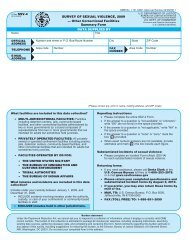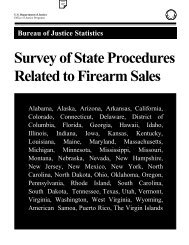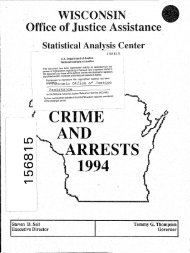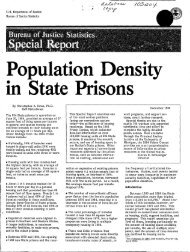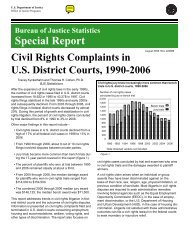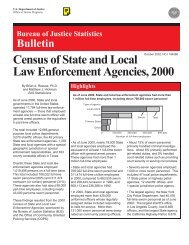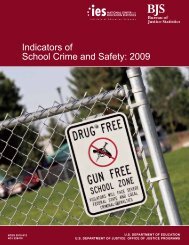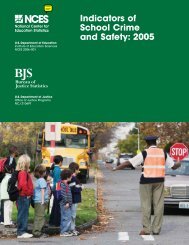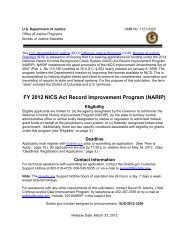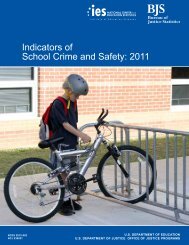Research design and proceduresN'PENDIX 10Student Drug Use in America, 1975-1982-Survey methodology and definitions af termsNJTE: The following is excerpted from Lloyd D. Johnston, Jerald G. Bachman, and Patrick M.O'Malley, Student Drug Use, Attitudes and Beliefs National Trends 19!5-1982, U.S.Department <strong>of</strong> Health and Htxl1an Services, Notional Institute on Drug Abuse (Washington, D.C.:U.S. Government Printing Office, 1982), pp. 3-7; and information provided by the Source.The basic research design involves annual data collections fromhigh school seniors during the Spring <strong>of</strong> each year, beginning with theclass <strong>of</strong> 1975. Data collection takes place in approximately 125 to 140public and private high schools selected to provide an accurate crosssection <strong>of</strong> high school seniors throughout the United States.One limitation in this design is that it does not include in thetarget population those young men and women who drop out <strong>of</strong> highschool before the last few months <strong>of</strong> their senior year (j.e., prior to thesurvey)--between 15 to 20 percent <strong>of</strong> each age cohort. The omission<strong>of</strong> high schaol dropouts does introduce biases in the estimation <strong>of</strong>certain characteristics <strong>of</strong> the entire age group; however, for mostpurpo£es, the small proportion <strong>of</strong> dropouts sets outer limits on the bias.Further, .since the bias from missing dropouts should remain just aboutconstant from year to year, their omission should introduce little biasinto the various types <strong>of</strong> change being estimated for the majority <strong>of</strong>the population. . ..Sampling procedures--The procedure for securing a nationwidesample <strong>of</strong> high school seniors is a multistage one. Stage I is theselection <strong>of</strong> particular geographic areas; Stage 2 is the selection <strong>of</strong> oneor more high schools in each area; and Stage 3 is the selection <strong>of</strong>seniors within each high school.Stage 1--The geographic areas used in this study are theprimary sampling units (PSUS) developed by the Sampling Section<strong>of</strong> the Survey Research Center for use in the Center's nationwideinterview studies. These consist <strong>of</strong> 74 primary areas throughoutthe coterminous United States. In addition to the 12 largestmetropolitan areas, containing about 30 percent <strong>of</strong> the Notion'spopulation, 62 other primary areas are included: lOin theNortheast, 18 in the North Central area, 24 in the South, and 10in the West. Because these same PSUs are used for personalinterview studies by the Survey Research Center, local fieldrepresentatives can be assigned to administer the data collectionsin practically 011 schools.Stage 2--ln the major metropolitan areas more than onehigh school is <strong>of</strong>ten included in the sampling design; in mast othersampling areas 0 single high school is sampled. In all cases, theselections <strong>of</strong> high schools are made such that the probability <strong>of</strong>drawing a school is proportionate to the size <strong>of</strong> its senior class.The larger the senior class (according to recent records), thehigher the selection probability assigned to the high school.When a sampled school is unwilling to participate, a replacementschool os similar to it as possible is selected from the sameg~ographical orea.Stage 3--Within each selected schoo!, up to about 400seniors may be included in the data collection. In schools withfewer than 400 seniors, the usual procedure is to include all <strong>of</strong>them in the data collection. In larger schools, a subset <strong>of</strong> seniorsis selected either by randomly sampling classrooms or by someother random method that IS convenient for the school ond judgedto be unbiased. Sample weights are assigned to each respondentso as t.: ,' voriations inselection probabilities occurring at the earlier stages <strong>of</strong> sampling.The three-stage sampling procedure described above yielded thenumber <strong>of</strong> participating schools and students presented in Table I.Table IClass <strong>of</strong>1975 1976 1977 1978 1979 1980 1981 1982Total number<strong>of</strong> schools 125 123 124 131 131 127 12!l 137Public III 108 108 III III 107 109 116Privote 14 15 16 20 20 20 19 21Students porticipating: a~ber 15,791 16,678 18,436 18,924 16,662 16,524 18,267 18,661Percent 78 77 79 83 82 82 81 83Each school (except for half <strong>of</strong> those in the 1975 data collection)was asked to participate in two data collections, thereby permittingreplacement <strong>of</strong> half <strong>of</strong> the total sample <strong>of</strong> schools each year. Onemotivation for requesting that schools participate for 2 years isadministrative efficiency; it is a costly and time-consuming procedureto secure the cooperation <strong>of</strong> schoolS, and a 2-year period <strong>of</strong>participation cuts down that effort substantially. Another importantadvantage is that whenever an appreciable shift in scores from one654graduating class to the next is observed, it is possible to checkwhether the shift might be attributable to some differences in thenewly sampled schools. This is done simply by repeating the analysisusing only the 60 or so schools that participated both years. Thus far,the half-sample appraach has worked quite well; an examination <strong>of</strong> drugprevalence data from the "matched half-samples" showed that the halfsamples<strong>of</strong> repeat schools yielded drug prevalence trends that werevirtually identical to trends based on all schools.Definitions <strong>of</strong> termsCollege plans--Respondents were asked the question "How likelyis it that you will do each <strong>of</strong> the following things after high school?"One <strong>of</strong> the alternatives listed is "gradUate from college (four yearprogram)." Seniors responding "definitely won't" or "probably won't"were assigned to the college plans category "none or under 4 years."Students responding "probably will" or "definitely will" were assigned tothe college plans category "complete 4 years."Region--States grouped as "I'hrtheast" (Census classifications <strong>of</strong>New England and Middle Atlanticl: Maine, New Hampshire, Vermant,Massachusetts, Rhode Island, Connecticut, New York, New Jersey, andPennsylVania. States grouped as "North Central" (Census classifications<strong>of</strong> East North Central and West North CentraD: Ohio, Indiana, Illinois,Michigan, Wisconsin, Minnesota, Iowa, Missouri, North Dakota, SouthDakota, Nebraska, and Kansas. States grouped as "South" (Censusclassifications <strong>of</strong> South Atlantic, East South Central and West SouthCentraJ): Delaware, Maryland, District <strong>of</strong> Columbia, Virginia, WestVirginia, North Carolina, South Carolina, Georgia, Florida, Kentucky,Tennessee, Alabama, Mississippi, Arkansas, Louisiana, Oklahoma, andTexas. States grouped as "West" (Census classifications <strong>of</strong> Mountainand Pacific): Montana, Idaho, Wyoming, Colorado, New Mexico, Arizona,Utah, Nevada, Woshington, Oregon, and California.Population density:"Large SMSAs" inclL'des the 12 largest StandardMetropolitan Statistical Areas (SMSA) as <strong>of</strong> the 1970 census: NewYork, Los Angeles, Chicago, Philadelphia, Detroit, Son Francisco,Washington, Boston, Pittsburgh, Sf. Louis, Baltimore, andCleveland.''Other SMSAs" include all other Standard MetropolitanStatistical Areas excluding the 12 above. Except in the NewEngland States, an SMSA is a county or group <strong>of</strong> contiguouscounties that contains at 1"I1.y: household respondents, self-respondents,and proxy respondents.I. Household respondent--A household respondent waschosen to answer questions that pertained to the entirehousehold. Items asked <strong>of</strong> the household respondent included suchquestions as whether the residence was owned or rented and totalfamily income. In addition, the household respondent was asked aseries <strong>of</strong> household "screen" questions, designed to elicitinformation concerning crimes against the household such asburglary and auto theft.The interviewer was instructed to interview aknowledgeable adult household member as the householdrespondent; that is, one who appeared to know--or who couldreasonably be expected to know--the answers to the householdquestions. For the data presented in this SOURCEBOOK, thisusually was the head <strong>of</strong> the household or the spouse <strong>of</strong> the head<strong>of</strong> the household. If it became apparent that the particularhousehold member being interviewed was unable to answer thesequestions, a more knowledgeable respondent was found, orarrangements were made to call back when a knowledgeablerespondent was available.2. Self-respondent--Questions that pertained to individualvictimization were asked <strong>of</strong> each household member 14 years <strong>of</strong>age or older. The questions asked <strong>of</strong> each Individual memberinclude personal characteristics and whether they were victimizedin some way during the preceeding 6 months.3. Proxy respondent--Information about each householdmember aged 12 and 13 was obtained by a proxy; that is, thequestions for these persons were asked <strong>of</strong> the householdrespondent or some other knowledgeable adult household member.Proxy respondents were also utilized for those household memberswho were physically or mentally unable to answer the individualquestions, as well as for those household members who weretemporarily absent and not expected to return within theenumeration period.Commercial interviews--For the commercial portion <strong>of</strong> thesurvey, either the owners or the managers <strong>of</strong> the commercl alestablishment were to be interviewed. If the owner or manager wa.not available at an establishment, the interviewer asked for the nam,~and telephone number so that he/she could make an appointment for aninterview. If the owner or manager was temporarily absent for theentire Interview period, or was ill for the entire period, or was toobusy, or if the interviewer could not obtain an interview for some otherreason, the interview was conducted with the assistant manager, an655accountant, the senior sales-clerk, the nurse, secretary, receptionist,or some other employee who was knowledgeable about the business.The conmercial survey was suspended as <strong>of</strong> 1977.QuestionnairesI-husehold portion--The questionnaire used in the householdsurvey had four parts. The first portion <strong>of</strong> the questionnaire completedby the interviewer consisted <strong>of</strong> such items as basic householddemographic data and pertinent information concerning noninterviews.The second portion, asked <strong>of</strong> the household respondent, was designed toobtain--for the purpose <strong>of</strong> describing the household--characteristics <strong>of</strong>the household members i2 years <strong>of</strong> age or older as well as to elicitgeneral information concerning crimes committed against the householdas a whole during the reference period. Items :ncluded in this sectionIncluded such "screen" questions as: "During the last 6 months, didanyone break into or somehow illegally get into your home, garage, oranother building on your property?" and "Did anyone steal or try tosteal, or use your motor vehicle without permission?"The third portion <strong>of</strong> the household questionnaire was asked <strong>of</strong>each household member 12 years <strong>of</strong> age or older, or a proxy. Itconsisted <strong>of</strong> items <strong>of</strong> person characteristics, such as educationalattainment and marital status, as well as individual "screen" questions,desi gned to elicit whether or not the respondent had been the victim <strong>of</strong>a specific crime during the reference period. For example, thefollowing questions were asked: "Did anyone take something directlyfrom you by using force, such as by a stickup, mugging or threat?" and"Did anyone beat you up, attack you or hit you with something, such asa rock or bottle?"The final portion <strong>of</strong> the household questionnaire, the CrimeIncident Report, was used to gather detailed information about crimesreported in either the household screen section (portion II) or theindividual screen section (portion III). One incident report was filledout for each incident reported in answer to a screen question. Forexample, if a respondent said that her purse was snatched once andthat she had been beaten up twice, three Crime Incident Reports--onefor each seporate incident--were completed.Commercial--The commercial victimization questionnaire hadthree primary components. The first contained questions that enabledthe interviewer to classify the type <strong>of</strong> establishment, non interviewreasons, gross income, ownership, and number <strong>of</strong> employees. Thesecond portion contained "screen" questions regarding whether anyburglaries and/or robberies had occurred during the reference periodand, if so, how many. This part ion also included questions regardinginsurance coverage and security measures used by the establishment.The final portion <strong>of</strong> the commercial questionnaire consisted <strong>of</strong>robbery and burglary incident reports. These detailed reports werefiled on every robbery and burglary incident reported in the screenquestionnaire. Seporate reporting forms were used for robbery andburglary incidents for the survey period from July 1972 throughDecember 1972. Beginning in January 1973, the same i nci dentreporting form was used to record details <strong>of</strong> both robbery and burglaryincidents.Changes in the 1979 Household QuestionnaireIn 1979, a revised questionnaire was used in the householdsurvey. To be able to make data comparable across years,specifications were given for reformatting the recponses from the newquestionnaire to coincide with the old survey questionnaire. Tablesconstructed for SOLRCEBOCK are based on the format <strong>of</strong> the old surveyquestionnaire. However, for Tables 3.6 and 3.14, it was not alwayspossible to reformat the new respanse categories (and hence columndistributions) to those from the old questionnaire. The result is thatthe tables presented in this edition <strong>of</strong> SOURCEBOOK are notcomparable to those presented in earlier editions. To aid the reader,the table below compores the response codes for these variables fromthe 1978 and revised 1979 questionnaires.
- -~~ - -~-----~~ ----------~-------------__•___ 0.' '-"<strong>Sourcebook</strong> <strong>of</strong> <strong>Criminal</strong> <strong>Justice</strong> <strong>Statistics</strong> <strong>1983</strong>AppendicesTable 3.6 Reasons for not reporting the victimization to the police1978 CodesI'bthing could be done--Iack <strong>of</strong>pro<strong>of</strong>Did not think it importantenoughPolice wouldn't wont to bebotheredDid not wont to toke time-too inconvenientPrivate or personal motter, didnot wont to report itDid not wont to get involvedAfraid <strong>of</strong> reprisalReported to someone elseOther--specifyI'bt ascertainedConfidentiality1979 CodesLock <strong>of</strong> pro<strong>of</strong>, no way t<strong>of</strong>ind/identify <strong>of</strong>fenderRespondent did not think itimportant enoughPolice wouldn't think it wasimportant enough, theywouldn't wont to be botheredDid not wont to toke time-too inconvenientPrivate or personal matter ortook core <strong>of</strong> it myselfI'b compal able codeAfraid <strong>of</strong> reprisal by <strong>of</strong>fenderor his family/friendsReported to someone elseObject recovered or <strong>of</strong>fenderunsuccessfulDidn't realized crime happenedtilllaterProperty difficult to recoverdue to lock <strong>of</strong> serial or I.D.numberpolice would be inefficient,ineffective, insensitive (theywould arrive late, wouldn'tpursue case properly, wouldharass/insult respondent, etc.)Other--specifyI'bt ascertainedA notice <strong>of</strong> confidentiality appeared on both the household andthe commercial questionnaires, indicating to the respondent that theanswers given were confidential by iaw and could be seen only bysworn U.S. <strong>Bureau</strong> <strong>of</strong> the Census personnel.I'btional sampling procedures and standard errors <strong>of</strong> the estimatesAll <strong>of</strong> the National Crime Survey data presented are populationestimates derived from nationwide probability samples. The samplesused for the notional survey are large; during a 6-manth period, about60,000 household interviews and 135,000 personal interviews areconducted. Nevertheless, whenever samples <strong>of</strong> a population--ratherthan the entire population--are studied, a certain amount <strong>of</strong> samplingerror is introduced into the results. The size <strong>of</strong> this error depends onsuch factors as the size <strong>of</strong> the sample and the variability <strong>of</strong> thepopulation. However, the sampling design and techniques were carriedout in a way'that permits on estimation <strong>of</strong> the amount <strong>of</strong> samplingerror present in the results.656Table :1.14 Place <strong>of</strong> occurrence <strong>of</strong> victimization1978 C~des. ________________ ~19~7~9_C=0~d~e~:; ______________ _At or !n own dwelling, ingarr.:ge or other building onp~operty (includes break-in orattempted break-in)At or In vocation home,hCltel/motelIn;lide non-residential bui/ding,pu:~lIc conveyance (Includesstore, restaurant, bonk, gasst(.ltlon, public conveyance orstc·tlon, <strong>of</strong>fice, factory,wa.-ehouse)Neer own home; yard, sidewalk,driveway, carport, apartmenthall (does not include break-inor 'Jttempted break-in)On the street, in pork, field,playground, school grounds orparking lotInside schoolElsewhereI'bt ascertainedAt or in own dwelling, or owngarage (always mark for breakinor attempted break-in <strong>of</strong>some)At or in detached buildings onown property such as detachedgarage, storage shed, etc.{Always mark for break-in orattempted break-in <strong>of</strong> someAt or in vocation home,hotel/motelInside restaurant, bar,nightclubInside other commerclaibuildingsuch as store, bonk, gas stationOn public transportation or instation (bus, train, plane,airport, depot, etc.)Commercial parking lotInside <strong>of</strong>fice, factory, orwarehouseNear own home; yard,sidewalk, driveway, carport, onstreet immediately adjacent toown home, apartmenthall/storage area/laundry room(does not include apartmentparking lots)On the street (other thanimmediately adjacent tooWn/friend/relative/neighbar'shome)I'bncomnercial parking lotAportment parking lotOn school property (schoolparking area, ploy area, schoolbus, etc.)In a pork, field, playgroundother than schoolInside school buildingAt, in, or near afriend/relative /neighbor'shome, other building on theirproperty, yard, immediatelyadjacent to their home,apartment hall/storagearea/laundry roomI'bt ascertainedThe sample <strong>of</strong> particular households or businesses actually drownIs only one <strong>of</strong> on extremely large number <strong>of</strong> different samples thatcould have been drown. If all possible samples <strong>of</strong> a given size were tobe drown from a popUlation and the sample results were used toestimate the popUlation value for a particular characteristic, theestimates from the samples would differ somewhat from each other.These differences are distributed in a known way, however, andstatistical sampling theory can give on ideo <strong>of</strong> how much confidencecan be placed in the estimate <strong>of</strong> a popUlation characteristic that isd::rived from a sample <strong>of</strong> a given size. Using a statistic called thestandard error <strong>of</strong> the estimate, we can create on interval around thesample characteristic in such a way as to know the probability thatir.tervals mode in thi~ manner contain the population characteristic.Because the method utilized in the production <strong>of</strong> these standarderrors and confidence intervals is based on approximations, thestandard errors are on Indication <strong>of</strong> the order <strong>of</strong> magnitUde <strong>of</strong> thestandard error rather than the precise standard error, for any specificitem. I t should be noted that as finer and finer breakdowns <strong>of</strong> thepopulation are mode--for example, along dimensions <strong>of</strong> race, income,age, etc.--the size <strong>of</strong> the standard error, relative to the size <strong>of</strong> theestimate, can be expected to increase. ---\j{·i;i:1IJ!rI:I : ijIIIIiIDefinitions <strong>of</strong> personal crime categoriesI. Rope ond ottempted rape--Rape was the method <strong>of</strong>attock; or the type <strong>of</strong> injury suffered; or there was a verbalthreat <strong>of</strong> rope; or the method <strong>of</strong> attock was attempted rope; orthere was attempted rope injuries suffered. This categoryincludes victimizations both with and without theft.2. Robbery--Aggregates categories 3, 6, and 7 below.3. Robbery.; nd attempted robbery with injury-Aggregates categories 4 and 5 below.4. Robbery and attempted robbery with injury, seriousassault--In a personal confrontation, something was stolen ortoken without permission from the victim; or there was onattempt to steal or toke something without permissioh; and thevictim suffered a serious injury. The robbery mayor may nothave involved a weapon.5. Robbery and attempted robbery with Injury, minorassault--In a personal confrontation, something was stolen ortoken without permission from the victim; or there was onattempt to steal or toke something without permission; and the<strong>of</strong>fender hod no weapon or the victim did not know whether the<strong>of</strong>fender hod a weapon; and the victim was attacked in somefashion; and received minor injuries. a6. Robbery, without injury--In a personal confrontation,something that belonged to the victim was stolen or tokenwithout permission; and the victim was threatened or attacked,but not injured in any way. Victimizations in which the <strong>of</strong>fenderhod a weapon as well as those in which the <strong>of</strong>fender did not havea weapon are included.7. Attempted robbery without injury--In a personalconfrontation, the <strong>of</strong>fender attempted to steal something; and thevictim was threatened or attacked, but not injured in any way.Victimizations in which the cffender hod a weapon as well asthose in which the <strong>of</strong>fender did not have a weapon are included.8. Assault--Aggregates categories 9 and 12 below.9. Aggravated assault--Aggregates categories 10 and I Ibelow.10. Aggravated assault with injury--I'bthing was stolenor token without permission, nor was there on attempt to steal ortoke something without permission; and the victim suffered aserious injury. The a5SQu/t mayor may not have involved aweapon.II. Aggravated assault, attempted assault withweapon--I'bthing was stolen or token without permission, norwas there on attempt to steal or take something withoutpermission; and the <strong>of</strong>fender hod a weapon; and the victim wasthreatened with harm, or was actually attacked but received noinjury.12. Simple assault--Aggregates categories 13 and 14below.13 Simple assault with injury--I'bthing was stolen ortoken without permission, nor was there on attempt to steal ortoke something without permission; and the <strong>of</strong>fender hod noweapon, or the victim did not know whether the <strong>of</strong>fender hod aweapon; and the victim was attacked in some fashion; andreceived minor injuries.14. Simple assault, attempted assault withoutweapon--I'bthing was stolen or token without permission, norwas there on attempt to steal or toke something withoutpermission; and the <strong>of</strong>fender did not have a weapon; and thevictim was threatened with harm, or was actuallY attacked butreceived no injury.15. Personal larceny with coo.tact--Aggregatescategories 16, 17, and IB below.16. Personal larceny with contact, purse !;natching--Apurse was token from the person; and the <strong>of</strong>fender did not have aweapon; and the victim was not threatened with harm or actuallyattacked.17. Personal larceny with contact, attempted pursesnatching--An attempt was mode to toke a purse from theperson; and the <strong>of</strong>fender did t.
- Page 1 and 2:
u.s. Department of JusticeBureau of
- Page 3 and 4:
________ n~'·••SOURCEBOOKOF CR
- Page 5 and 6:
Sourcebook of Criminal Justice Stat
- Page 7 and 8:
Figure B An overview of detelnclude
- Page 9 and 10:
--------- - --Svurcebook of Crimina
- Page 11 and 12:
- - .. "-- - ~------~ ------------C
- Page 13 and 14:
Figure3.12 Estimated rate (per 100,
- Page 15 and 16:
TableFig. 2.6 Respondents taking pr
- Page 17 and 18:
Sourcebook of Criminal Justice Stat
- Page 19 and 20:
---------- - -- ~------------------
- Page 21 and 22:
- ...... - ~r---~---------~--------
- Page 24 and 25:
------------- - ~------~-----~-----
- Page 26 and 27:
Sourcebook of Criminal Justice Stat
- Page 28 and 29:
--------- -' -- - -'-- ----~-------
- Page 30 and 31:
---- -- --~------~ ---rl.Sourcebook
- Page 32 and 33:
~~---------- ---~----------~-------
- Page 34 and 35:
-------------- - ---~---~--------~-
- Page 36 and 37:
~~~~~~~---- - -- -Sourcebook of Cri
- Page 38 and 39:
----.... ....--.-. ~"'-.~Sourcebook
- Page 40 and 41:
(Sourcebook of Criminal Justice Sta
- Page 42 and 43:
-----~---------------------.-'-----
- Page 44 and 45:
Table 1.13 Number and rateOct. 31,
- Page 46 and 47:
~-~- ~-...--~ -- ~ ---,~-------. -.
- Page 48 and 49:
-- ..... -,-.--..-... ~~----r; __ '
- Page 50 and 51:
---..0lIl, - -~,..--- -- - - ----~-
- Page 52 and 53:
-----------------------------------
- Page 54 and 55:
.~------~--------------------------
- Page 56 and 57:
"Sourcebook of Criminal Justice Sta
- Page 58 and 59:
------------ - -- -"\I'Sourcebook o
- Page 60 and 61:
Sourcebook of Criminal Justice Stat
- Page 62 and 63:
Sourcebook of Criminal Justice Stat
- Page 65 and 66:
---- ~------~--~- -..---Sourcebook
- Page 67 and 68:
Sourcebook of Criminal Justice Stat
- Page 69 and 70:
.~f'ISourcebook of Criminal Justice
- Page 71 and 72:
Characteristics of the Criminal Jus
- Page 73 and 74:
f'Sourcebook of Criminal Justice St
- Page 75 and 76:
--'~--~---------------_..."'.".,..,
- Page 77 and 78:
'Sourcebook of Criminal Justice Sta
- Page 79 and 80:
------ ~---~-----~-----~Sourcebook
- Page 81 and 82:
-----------~-~---~-------Sourcebook
- Page 83 and 84:
-----~---~~~. -'""".-=-./}Character
- Page 85 and 86:
--------------------Sourcebook of C
- Page 87 and 88:
-----------------------------------
- Page 89 and 90:
[!r-·ISourcebook of Criminal Justi
- Page 91 and 92:
- _. - -------~--...;--~"-"----- --
- Page 93 and 94:
.~. ---..ot--~.....--- -- ~------_.
- Page 95 and 96:
Sourcebook of Criminal Justice Stat
- Page 97 and 98:
--""'1,- ~,.--- --_'M~II!tlT'-~'r.
- Page 99 and 100:
- -~--~--~-~~-------~----------Tabl
- Page 101 and 102:
~~--~~--~-----~ ----Sourcebook of C
- Page 103 and 104:
~-~-------------------------_--____
- Page 105 and 106:
------------Sourcebook of Criminal
- Page 107 and 108:
Sourcebook of Criminal Justice Stat
- Page 109 and 110:
Characteristics of the Criminal Jus
- Page 111 and 112:
------- -- - -- -Sourcebook of Crim
- Page 113 and 114:
"Sourcebook of Criminal Justice Sta
- Page 115 and 116:
Sourcebook of Criminal Justice Stat
- Page 117 and 118:
------"'--~ ,'~- =--Sourcebook of C
- Page 119 and 120:
Sourcebook of Criminal Justice S;at
- Page 121 and 122:
,,iSourcebook of Criminal Justice S
- Page 123 and 124:
Source: George H. Gallup, The Gallu
- Page 125 and 126:
----~------~~--~----------~--------
- Page 127 and 128:
Sourcebook of Criminal Justice Stat
- Page 129 and 130:
--------------Sourcebook of Crimina
- Page 131 and 132:
--~-~~~~---------'---Public Attitud
- Page 133 and 134:
---------------------Sourcebook of
- Page 135 and 136:
-----------------------------------
- Page 137 and 138:
----------- --~-_.------~---t]Sourc
- Page 139 and 140:
Sourcebook of Criminal Justice Stat
- Page 141 and 142:
234Sourcebook of Criminal Justice S
- Page 143 and 144:
Sourcebook of Criminal Justice Stat
- Page 145 and 146:
~---.-.-.~~~ .. ~.Sourcebook of Cri
- Page 147 and 148:
,~--------~---------------~--------
- Page 149 and 150:
-~---------i': 1r\ jI~1 Public Atti
- Page 151 and 152:
--~---------------~----------Source
- Page 153 and 154:
~-~ - -'--~-------~----~~----------
- Page 155 and 156:
~-~- ~-----------------------------
- Page 157 and 158:
· -.Figure 2.14 Attitudes toward t
- Page 159 and 160:
Sourcebook of Criminal Justice Stat
- Page 161 and 162:
Sourcebook of Criminal Justice Stat
- Page 163 and 164:
--"'" - -~--..--- -Sourcebook of Cr
- Page 166 and 167:
.,.----------- - --" ,,jSourcebook
- Page 168 and 169:
~---~----~---" '--Sourcebook of Cri
- Page 170 and 171:
Sourcebook of Criminal Justice Stat
- Page 172 and 173:
....... ,-"'-~--... ~.Sourcebook of
- Page 174 and 175:
-- ..... --~.....-- -- -~ --'\,j--S
- Page 176 and 177:
"~Sourcebook of Criminal Justice St
- Page 178 and 179:
--~----- --~-----r\ I,I.-------. "
- Page 180 and 181:
---------------------,-------------
- Page 182 and 183:
Sourcebook of Criminal Justice Stat
- Page 184 and 185:
--------------------_.;e __ ... , .
- Page 186 and 187:
-----_.----------------------------
- Page 188 and 189:
--~--~-...---Sourcebook of Criminal
- Page 190 and 191:
----....--,-"..__._-..- ~ -- ~~ ...
- Page 192 and 193:
-- ..... -~-..---=4'CI)("")CI)9:::s
- Page 194 and 195:
-~-~ -----------------Sourcebook of
- Page 196 and 197:
Nature and Distribution of Known Of
- Page 198 and 199:
--------.-~ '-'=~~-------- -- -I1Na
- Page 200 and 201:
Nature and Distribution of Known Of
- Page 202 and 203:
---------~----------------~--------
- Page 204 and 205:
-------'''*'''_''' __ ,~=IW".(ISour
- Page 206 and 207:
;1INoture ond Distribution of /
- Page 208 and 209:
~~~-~----- ---- -~---~---~--~~-----
- Page 210 and 211:
Sourcebook of Criminol Justice Stat
- Page 212 and 213:
~ ---~ ---------- - ---Sout!:eboci<
- Page 214 and 215:
- ~--J."'~~~"_~ ..~F'"-_ ....Source
- Page 216 and 217:
Nature and Distribution of Known Of
- Page 218 and 219:
--------"Source bo 0 k of Crimi no
- Page 220 and 221:
Sourcebook of Criminol Justice Stat
- Page 222 and 223:
"---- ~ -------~~ -----------------
- Page 224 and 225:
.------~~- --~Sourcebook of Crimina
- Page 226 and 227:
396----------- -- ~Sourcebook of Cr
- Page 228 and 229:
Sourcebook of Criminal Justice Stat
- Page 230 and 231:
--Agure 3.24 Rate (per 100 officers
- Page 232 and 233:
407-~------- ----Sourcebook of Crim
- Page 234 and 235:
------------- -- ~Sourcebook of Cri
- Page 236 and 237:
Characteristics and Distribution of
- Page 238 and 239:
---.0lIl, - ~-.,---------- . ---Sou
- Page 240 and 241:
--~----~c,Sourcebook of Criminal Ju
- Page 242 and 243:
------------ - -- ----- --------~II
- Page 244 and 245:
- ----~--~\"r--. 'I[I)1Ir ri II.~\,
- Page 246 and 247:
.~--,..., - -~ --..--- --~ ----~---
- Page 248 and 249:
-------_ .. -Sourcebook of Criminal
- Page 250 and 251:
Sourcebook of Criminal Justice Stat
- Page 252 and 253:
----.------------------------------
- Page 254 and 255:
------------ - ~"Sourcebook of Crim
- Page 256 and 257:
Sourcebook of Criminal Justice Stat
- Page 258 and 259:
-------- --------~------------rSour
- Page 260 and 261:
-~--~......--- --------------------
- Page 262:
Sourcebook of Criminal Justice Stat
- Page 265 and 266:
---~--- ----------- ---------------
- Page 267 and 268:
~--~----------~--------------------
- Page 269 and 270:
----------- _. ---~--------~------.
- Page 271 and 272:
Sourcebook of Criminal Justice Stat
- Page 273 and 274:
------------------- ---------------
- Page 275 and 276:
--"~ ~- .... -~--,-----Sourcebook o
- Page 277 and 278:
~-~--~......--- --------~--~- - ~--
- Page 279 and 280:
."Sourcebook of Criminal Justice St
- Page 281 and 282:
Sourcebook of Criminal Justice Stat
- Page 283 and 284:
Judicial Processing of DefendantsFi
- Page 285 and 286:
Sourcebook of Criminal Justice Stat
- Page 287 and 288:
Sourcebook of Criminal Justice ;ita
- Page 289 and 290:
--- ..... - ~-..--~--------. - ---I
- Page 291 and 292:
- ~-----~----~ -~--Figure 5.9 Civil
- Page 293 and 294:
'rIlfI. '"• ""' .. t.':>\._ ;~~,
- Page 295 and 296:
."Sourcebook of Criminol Justice St
- Page 297 and 298:
---------- - -- -Sourcebook of Crim
- Page 299 and 300:
Figure 5.11 Obscenity complaints re
- Page 301 and 302:
- ----..--~Sourcebook of Criminal J
- Page 303 and 304:
Sourcebook of Criminal Justice Stat
- Page 305 and 306:
--~- ~,,------------ -- ~JUdicial P
- Page 307 and 308:
Sourcebook of Criminal Justice Stat
- Page 309 and 310:
"Sourcebook of Criminal Justice Sta
- Page 311 and 312:
Table 6.4 Level31, 1981Sourcebook o
- Page 313 and 314:
Sourcebook of Criminal Justice Stot
- Page 315 and 316: ------ --------------------~-------
- Page 317 and 318: Sourcebook of Criminal Justice Stat
- Page 319 and 320: '""' - .----~-- ---~---------------
- Page 321 and 322: ---.0lIl,- ~--,.--- - - - ---------
- Page 323 and 324: Sourcebook of Criminal Justice Stat
- Page 325 and 326: ---~~--- --- - --Sourcebook of Crim
- Page 327 and 328: Sourcebook of Criminal Justice Stat
- Page 329 and 330: -------- ---~-Sourcebook of Crimina
- Page 331 and 332: :Sourcebook of Criminal Justice Sta
- Page 333 and 334: Sourcebook of Criminal Justice Stat
- Page 335 and 336: -'•Sourcebook of Criminal Justice
- Page 337 and 338: ,-.-~------......-~-----n.~-".~" ..
- Page 339 and 340: SourcebG,.lk of Criminal Justice St
- Page 341 and 342: Sourcebook of Criminal Justice Stat
- Page 343 and 344: -----------------------------------
- Page 345 and 346: ~~------r 'I,-Sourcebook of Crimina
- Page 347 and 348: Sourcebook of Cril"":inal Justice S
- Page 349 and 350: ----------- - -- ~------~-------~--
- Page 351 and 352: --------~~--- --- --~--- --------Na
- Page 353 and 354: Sourcebook of Crlmlnol Justice Stat
- Page 355 and 356: ---- - --------~Sources and Referen
- Page 357 and 358: - ---------~Expenditure and Employm
- Page 359 and 360: AppendicesPopulation definitionsJ!f
- Page 361 and 362: ,-Sourcebook of Criminal Justice St
- Page 363 and 364: Appendices"NJPENDIX 7Public opinion
- Page 365: --------------~-------APPENDIX 8ABC
- Page 369 and 370: ------------ - -APPENDIX 14APPENDIX
- Page 371 and 372: --~- ~-..---Estimating procedureSou
- Page 373 and 374: ------------------------~included i
- Page 375 and 376: ---~--------~--~------Sourcebook of
- Page 377 and 378: INDEXAbortionAbuse and neglectAcqui
- Page 379 and 380: --~--~--,,--682rCOLRTS-MARTIAL (con
- Page 381 and 382: ---....--~,..-- -- -~ --IndexJ\.RIE
- Page 383 and 384: ------- ~(ffiOSECUTIQ\J (continued)
- Page 385 and 386: Evaluation form forSourcebook Of Cr
- Page 387 and 388: ~ .... --------r~-- - --Bureau of J
- Page 389: -.'>(':;'~."'\-IIIi· "IfJ./II11III



